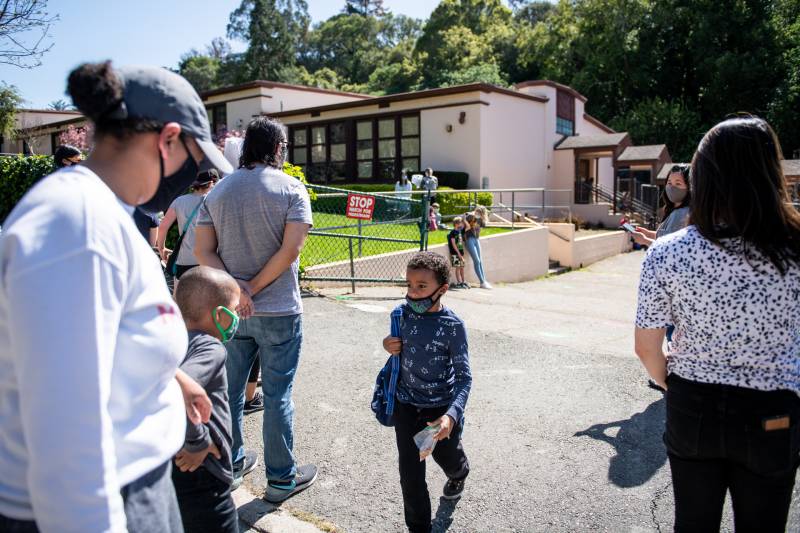
Despite this year’s return to in-person learning, districts throughout the state are seeing major declines in both enrollment and average daily attendance, and fear the reductions could result in significant funding cuts next school year.
Without state intervention, many districts face substantial cuts in state funding and could be forced to make significant budget cuts in the 2022-23 school year, due to a drop in enrollment and attendance. Districts’ baseline funding depends on the number of students enrolled, minus the daily average number of absent students.
For the past two school years, districts were “held harmless” for the declines during the pandemic and were funded based on their enrollment and attendance figures for the pre-COVID 2019-20 school year. But that will no longer be the case unless the Legislature extends the “hold harmless” rule or takes other action.
Statewide, enrollment in K-12 public schools in California fell by almost 3%, or 160,000 students, in 2020-21, according to annual data released in April by the California Department of Education. On Oct. 6, districts filed their “census day enrollment” figures, which is used in the state funding formula. Those figures likely won’t be made public until early next year.
West Contra Costa Unified, a district of about 26,000 students serving Richmond and surrounding areas, anticipates a loss of around $30 million in the 2022-23 school year barring no change in the funding formula, said Tony Wold, the district’s associate superintendent of business services.
Los Angeles Unified, San Francisco Unified and others also have seen significant enrollment drops over the past two years.
For West Contra Costa, the reduction would mean a loss of about 10% of the district’s overall budget and likely could result in staff layoffs or force district officials to dip into reserve funds.
“Knowing that approximately 90% of most districts’ budget is spent on people, a 10% reduction would affect people,” Wold said.
The district has already endured years of budget hurdles. In early 2020, it projected a $48 million ongoing structural deficit for 2020-21 and cut about $30 million in ongoing expenditures from its 2020-21 budget to break even. The district did, however, receive record one-time state and federal funding this year, and was able to stave off cuts during the current school year thanks to a 5.5% cost-of-living adjustment from the state.
Between the start of the pandemic in March 2020 and the start of the 2020-21 school year, the district lost about 800 students, Wold said. Though the district had anticipated that many of them would come back or move elsewhere by the following year, the decline more than doubled to just under 2,000 students this school year.
The enrollment drop was spread among every grade level. Some of it was due to families not enrolling their children in kindergarten and transitional kindergarten. Also, fewer students transitioned into high school from middle school and elementary to middle school, Wold said. It’s unclear where they went instead of staying in the district, Wold said.
He also chalked up some enrollment loss to COVID anxiety, especially among families of students who are younger than 12 and not yet able to get a vaccine. In addition, the district typically has a steady stream of immigrant families, but border restrictions have led to fewer newcomer students, he said.
Besides the enrollment drop, confusion over independent study and strict guidance requiring students with any COVID symptoms to stay home has led to an uptick in absences, and average daily attendance has gone down by about 4%, he said.
West Contra Costa is far from the only California district to experience such an enrollment drop. San Francisco Unified, which enrolled about 60,000 students in the 2018-19 school year, has lost about 3,500 students during the pandemic, The San Francisco Chronicle reported Tuesday. The district estimates a loss of about $35 million in state funding next year.
Los Angeles Unified, the largest school district in the state, lost more than 27,000 students — about 6% of its enrollment — since the 2020-21 school year, according to The Los Angeles Times.
Oakland Unified’s census-day enrollment count for the 2018-19 school year was 36,524. As of Oct. 5, the district projected enrollment of 34,378, Superintendent Kyla Johnson-Trammell said at a school board meeting Wednesday. Sacramento City Unified Superintendent Jorge Aguilar also has expressed concern about the impact of his district’s enrollment loss on its ongoing structural deficit.
West Contra Costa Unified is looking to state leaders to figure out a way to avoid devastating budget cuts in the 2022-23 school year.
“While under the current statute we would have to cut, the reality is the state has more money, and more money is supposed to come to education than before,” Wold said. “Rational minds should be able to come up with a solution, especially if it’s hitting every district.”
Wold recommends that average daily attendance be taken out of the equation for districts’ baseline state funding.
“Let’s say I have 10,000 students, and a 95% attendance rate. That means I’m getting funded for 9,500 students, but I still have to fund 10,000 Chromebooks, 10,000 textbooks and hire teachers and staff for 10,000 students,” Wold said.
He recommends average daily attendance be used just like supplemental concentration funding so that having a higher average daily attendance will result in a district getting a bonus — stimulating student attendance and providing support to get chronically absent students back in class — but not affect a district’s base funding.
Angelica Jongco, deputy managing attorney for Public Advocates, said the public interest law firm is hesitant to suggest doing away with average daily attendance permanently from the equation for districts’ baseline funding. Jongco said her fear would be taking away the accountability measure for districts and charter schools to address the ongoing issue of chronic absenteeism.
“Kids can only learn if they’re in school,” Jongco said. “We want to make sure districts are truly making all efforts possible to ensure students, especially the most vulnerable students, are getting to school every day.”
That being said, Public Advocates is looking to state lawmakers for short-term relief given the potential funding drop schools face in the 2022-23 school year. Even before the pandemic, Jongco said, districts were grappling with declining enrollment due to California’s surging housing prices, rapid gentrification and charter school growth. Since the state’s eviction moratorium expired this month, cities could see even more displacement of families with school-age children, she said.
Though enrollment may not return to pre-COVID numbers, Wold expects there to be an uptick in enrollment once the pandemic has further subsided. Without the funding to have a workforce in place to serve those students, districts would be left scrambling again to find teachers and staff. The district was already unable to fill about 50 teaching positions this school year due to a statewide teacher shortage. Those positions are being filled with long-term substitute teachers and educators who were previously assigned to other duties, such as working as math or reading specialists.
The clock is ticking for legislative action on any change to the district funding formula. Districts will begin filing their interim budget reports on Dec. 15 and April 18, and they will adopt their budgets by June 30. Those reports must reflect the funding formulas currently in place. If the budget recommendation reflects a $30 million shortfall by March 15, layoff notices will have to be sent out.
“We need the time and the grace to be able to continue to support our students,” Wold said. “Not knowing if we’re going to have some sort of lifeline doesn’t serve us well.”
[“source=allhomeliving”]

















